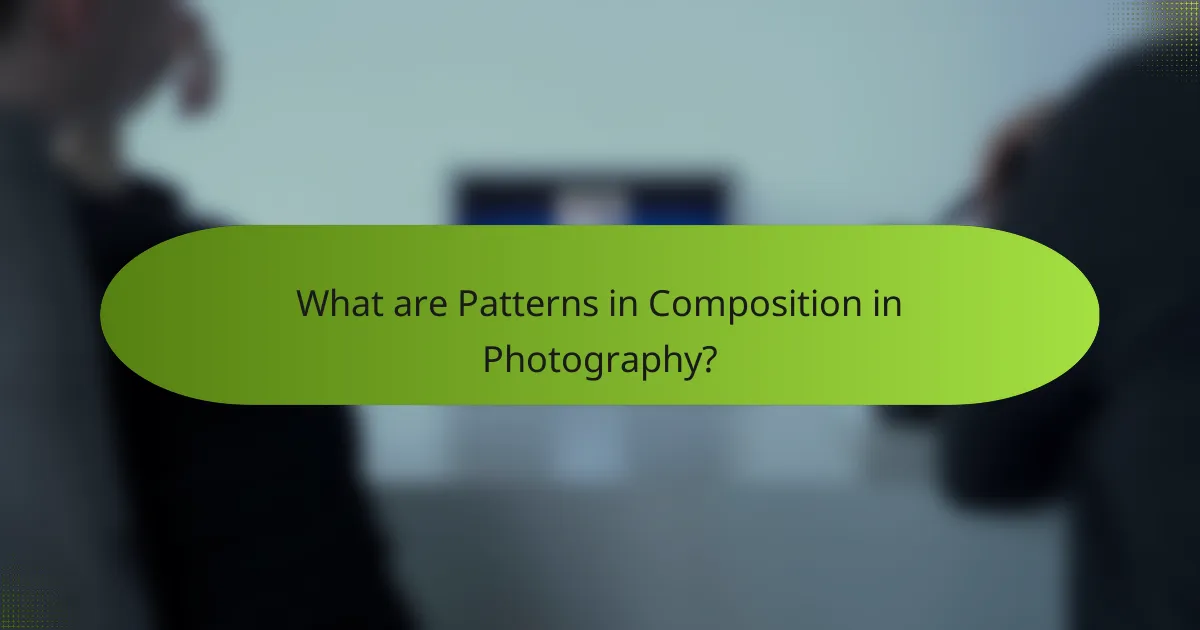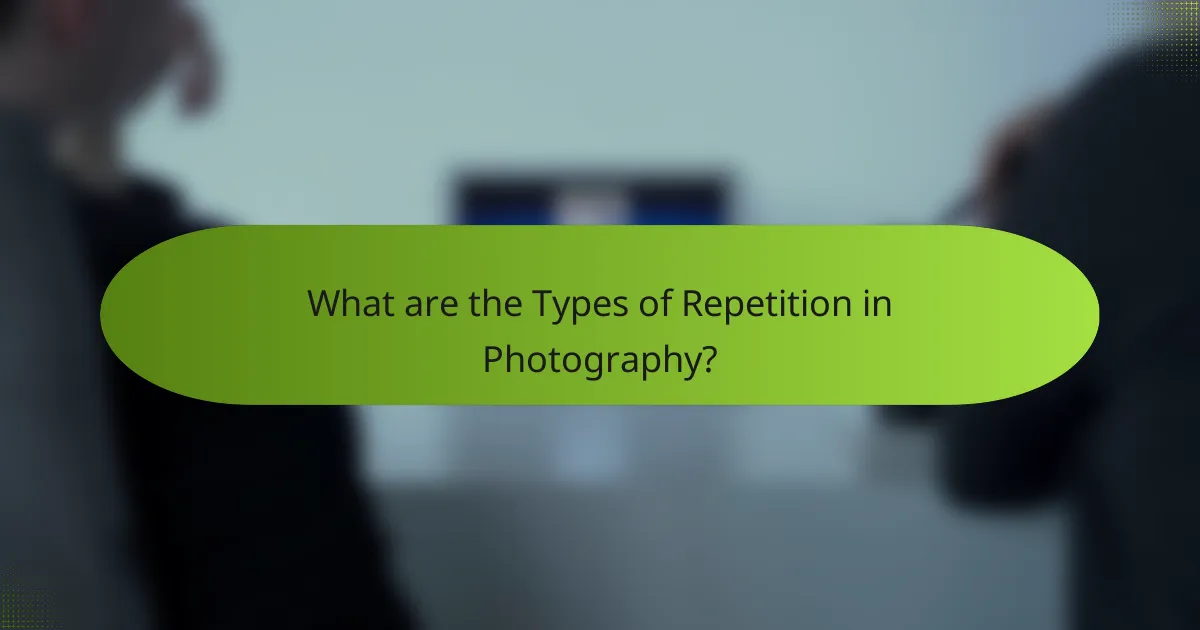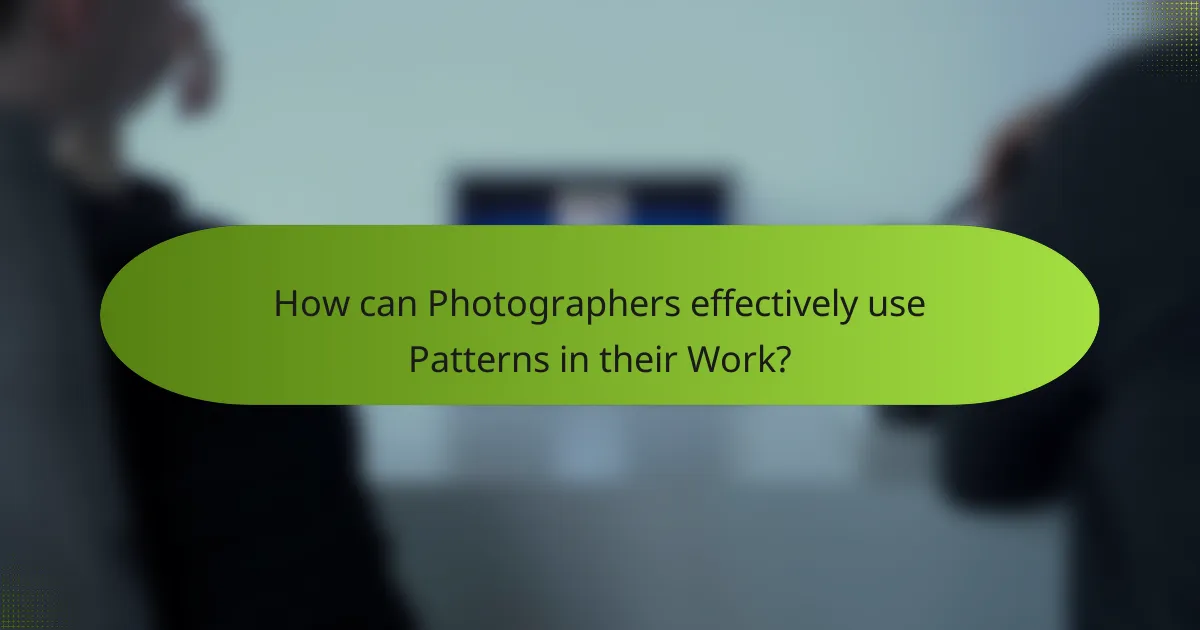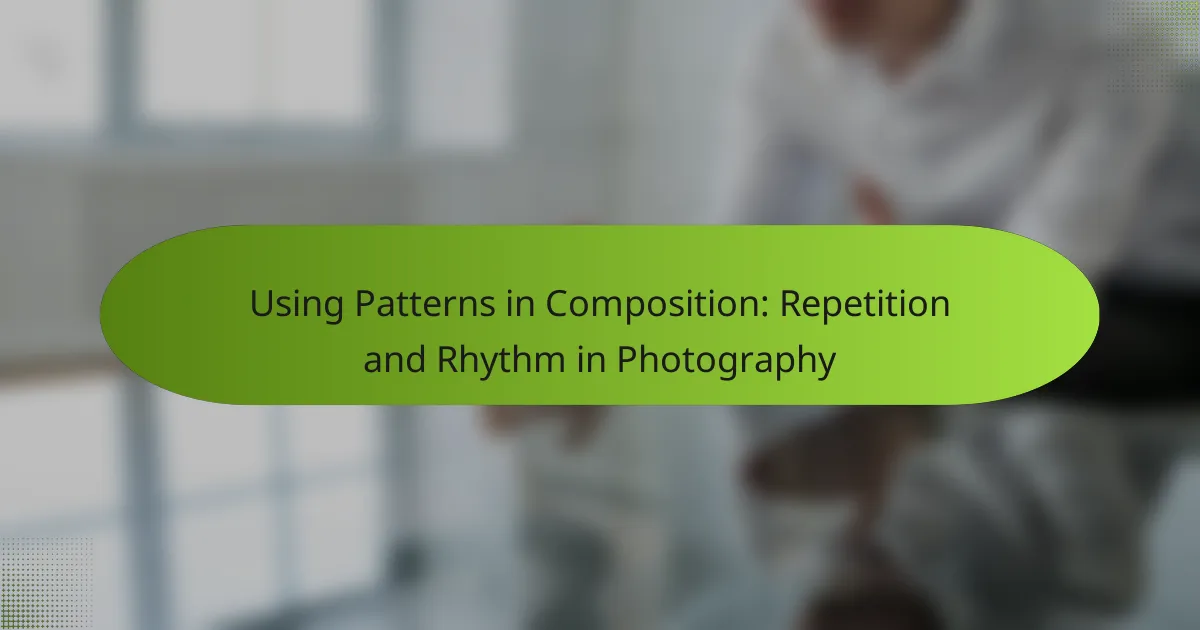
What are Patterns in Composition in Photography?
Patterns in composition in photography refer to the repeated elements or motifs within an image. These patterns can create visual interest and guide the viewer’s eye. Common types of patterns include geometric shapes, lines, colors, and textures. Photographers often utilize these patterns to enhance the structure of their images. By incorporating repetition, they can establish rhythm and harmony. Patterns can also evoke emotions and convey messages. This technique is widely recognized in art and design, proving its effectiveness in photography.
How do Repetition and Rhythm contribute to visual storytelling?
Repetition and rhythm enhance visual storytelling by creating a cohesive narrative through patterns. Repetition establishes familiarity and reinforces themes within the visual composition. It guides the viewer’s eye and creates a sense of unity. Rhythm, on the other hand, introduces movement and flow within the imagery. It can evoke emotions and set the pace of the story being told. Together, these elements create a structured experience that engages the audience. Studies in visual perception indicate that patterns help viewers process information more effectively. This reinforces the importance of repetition and rhythm in visual storytelling.
What is the significance of repetition in photographic composition?
Repetition in photographic composition creates visual harmony and enhances the viewer’s experience. It establishes a rhythm that guides the eye throughout the image. This technique draws attention to specific elements, reinforcing the main subject. Repetition can evoke emotions, creating a sense of unity or balance. For instance, patterns in nature or architecture can lead to striking compositions. Studies show that images with repeating elements are often more memorable. The use of repetition can also highlight contrasts, adding depth to the photograph. Overall, repetition is a fundamental principle that enriches photographic storytelling.
How does rhythm influence the viewer’s experience in photography?
Rhythm in photography influences the viewer’s experience by creating a sense of movement and flow. It guides the viewer’s eye through the composition. This can evoke emotions and enhance storytelling. Repeated elements establish a visual tempo. For example, a series of similar shapes can create harmony. Variations in size or color can add contrast and interest. Studies show that rhythm helps viewers engage more deeply with images. This engagement can lead to a more memorable experience.
Why are Patterns important in Photography?
Patterns are important in photography because they create visual interest and guide the viewer’s eye. They establish a sense of rhythm and harmony within the composition. Patterns can be found in nature, architecture, and everyday objects. By repeating shapes, colors, or textures, photographers can enhance the overall aesthetic appeal. This technique can lead to more engaging and impactful images. Research shows that patterns can evoke emotional responses and convey meaning. For instance, the use of symmetry in photography often creates a feeling of balance and tranquility.
What emotional responses can patterns evoke in viewers?
Patterns can evoke a range of emotional responses in viewers. They can create feelings of harmony and balance, as repetition often leads to a sense of order. Conversely, irregular patterns may induce feelings of tension or unease. Patterns can also evoke nostalgia, as familiar designs remind viewers of past experiences. Furthermore, dynamic patterns can stimulate excitement or energy, engaging viewers more actively. Research shows that visual patterns can influence mood and perception, as demonstrated in studies on visual stimuli and emotional responses.
How do patterns guide the viewer’s eye through an image?
Patterns guide the viewer’s eye through an image by creating visual pathways. These pathways help direct attention to focal points. Repetition of shapes, colors, or lines establishes rhythm. This rhythm encourages the viewer to explore the entire composition. Patterns can also create a sense of harmony and balance. They can lead the viewer’s gaze smoothly from one element to another. Research shows that viewers naturally follow lines and shapes in images. This phenomenon is rooted in human perception, which seeks order and familiarity.

What are the Types of Repetition in Photography?
The types of repetition in photography include direct repetition, indirect repetition, and rhythmic repetition. Direct repetition occurs when identical elements are repeated within a frame. This can create a strong visual impact. Indirect repetition involves similar elements that share characteristics, creating a cohesive look. Rhythmic repetition refers to a pattern that leads the viewer’s eye through the image. Each type effectively enhances composition and adds depth to photographs.
How can different forms of repetition enhance a photograph?
Different forms of repetition can enhance a photograph by creating visual harmony and drawing attention to specific elements. Repetition establishes rhythm, guiding the viewer’s eye through the composition. It can emphasize patterns, shapes, or colors, making the image more engaging. For instance, repeated elements like lines or shapes can create a sense of movement and depth. Studies show that images with clear repetitive patterns are often perceived as more aesthetically pleasing. This is due to the brain’s preference for symmetry and order. Additionally, repetition can evoke emotions and convey a narrative, enriching the viewer’s experience.
What are examples of symmetry and asymmetry in repetition?
Symmetry in repetition refers to balanced, mirror-like arrangements. An example is a row of trees evenly spaced on either side of a path. This creates a harmonious visual effect. Asymmetry in repetition involves uneven or varied arrangements. An example is a series of rocks scattered along a beach, differing in size and spacing. This creates a dynamic, interesting composition. Both symmetry and asymmetry enhance visual storytelling in photography. They guide the viewer’s eye and evoke different emotional responses. Symmetry often conveys order, while asymmetry can suggest movement or tension.
How does the use of color repetition affect composition?
Color repetition enhances composition by creating visual harmony and unity. It establishes a cohesive look that guides the viewer’s eye throughout the image. This technique can emphasize specific elements, making them stand out. For example, using a consistent color palette can evoke emotions and set the mood of the photograph. Studies show that images with color repetition tend to be more engaging. This is because the brain processes repeated colors more efficiently, leading to increased viewer retention. Therefore, effectively applying color repetition can significantly elevate the overall impact of a composition.
What techniques can be used to achieve rhythm in photography?
Techniques to achieve rhythm in photography include repetition of shapes, colors, and lines. Repetition creates a sense of movement and flow within the image. Leading lines can guide the viewer’s eye and establish a visual rhythm. Patterns in nature or architecture can also contribute to rhythmic compositions. The use of frames within frames adds depth and continuity. Varying the focal length can emphasize rhythmic elements in a scene. Using similar subjects at intervals enhances the feeling of rhythm. Lastly, adjusting the shutter speed can create motion blur, adding dynamic rhythm to the photograph.
How do leading lines create a sense of rhythm in images?
Leading lines create a sense of rhythm in images by guiding the viewer’s eye along a path. These lines establish a visual flow that can evoke movement. As the viewer follows the lines, they experience a repeated pattern that enhances the composition. This repetition can create a feeling of harmony and balance within the image. For example, a road or a river can lead the eye through different elements in the scene. The continuity of these lines helps to unify various components of the photograph. This technique is often used in landscape photography to enhance depth. The result is a more engaging and dynamic visual experience.
What role do shapes and forms play in establishing rhythm?
Shapes and forms are essential in establishing rhythm within photography. They create visual patterns that guide the viewer’s eye. Repeated shapes can reinforce a sense of movement. This movement enhances the overall composition. For example, a series of circular shapes can create a flowing rhythm. Conversely, angular forms may introduce a more dynamic and energetic rhythm. The arrangement of these shapes influences how rhythm is perceived. In photography, rhythm helps to create a cohesive visual narrative. This concept is supported by principles of design that emphasize repetition and harmony.

How can Photographers effectively use Patterns in their Work?
Photographers can effectively use patterns by incorporating repetition and rhythm in their compositions. Patterns create visual interest and guide the viewer’s eye through the image. They can be found in nature, architecture, and everyday objects. Using patterns helps to establish a sense of harmony and balance. For instance, a series of trees or windows can form a rhythmic pattern. This technique enhances the aesthetic appeal of photographs. Studies show that images with strong patterns attract more attention. Therefore, recognizing and utilizing patterns can significantly improve a photographer’s work.
What are best practices for incorporating repetition and rhythm?
Best practices for incorporating repetition and rhythm in photography include identifying consistent elements within a scene. This can involve repeating shapes, colors, or textures to create visual harmony. Use leading lines to guide the viewer’s eye through the composition. Establish a rhythm by varying the spacing and size of repeated elements. This variation can enhance interest while maintaining a cohesive look. Utilize patterns found in nature or architecture to reinforce repetition. Photographers often use techniques like framing and layering to emphasize rhythmic elements. These practices help to create a dynamic and engaging visual experience.
How can photographers identify and utilize patterns in their environment?
Photographers can identify and utilize patterns in their environment by observing repetitive elements in their surroundings. They should look for shapes, colors, and textures that recur, creating visual rhythm. This can include natural patterns like tree branches or man-made patterns like tiles. Photographers can enhance their compositions by framing these patterns effectively. Utilizing leading lines can guide the viewer’s eye through the pattern. They can also experiment with different angles to reveal hidden patterns. By focusing on light and shadow, photographers can highlight the texture within patterns. This approach has been shown to create more dynamic and engaging images.
What tips can help in creating a balanced composition with patterns?
To create a balanced composition with patterns, use contrast to highlight different elements. Contrast can be achieved through color, size, or texture. This helps to draw attention and create visual interest. Additionally, maintain a consistent rhythm by repeating certain patterns throughout the composition. This repetition helps unify the overall image. Consider the rule of thirds to position patterns effectively within the frame. This technique guides the viewer’s eye and enhances balance. Finally, pay attention to negative space, as it allows patterns to breathe and prevents overcrowding. Each of these tips contributes to a harmonious composition.
What common mistakes should photographers avoid when using patterns?
Photographers should avoid overusing patterns, as it can lead to visual clutter. This mistake often distracts from the main subject of the photo. Additionally, failing to consider the background can result in patterns that compete with the subject. Ignoring light and shadow can diminish the impact of patterns. Not varying the angle can cause images to feel repetitive and uninspired. Lastly, neglecting to experiment with scale can lead to missed opportunities for dramatic effects. Each of these mistakes can undermine the effectiveness of patterns in photography.
How can overuse of patterns detract from a photograph’s impact?
Overuse of patterns can detract from a photograph’s impact by creating visual confusion. When patterns dominate, they can overwhelm the viewer’s eye. This may lead to a lack of focal points in the image. Without clear subjects, the photograph can seem chaotic. Additionally, excessive patterns can dilute the emotional message of the photograph. Viewers might struggle to connect with the intended narrative. Research indicates that balance and contrast are crucial for effective composition. A study by David duChemin emphasizes that simplicity enhances viewer engagement. Thus, moderation in pattern use is essential for impactful photography.
What should photographers consider when mixing patterns and other elements?
Photographers should consider contrast, scale, and color harmony when mixing patterns and other elements. Contrast helps to differentiate patterns, making the composition visually engaging. Scale ensures that patterns do not overwhelm each other, maintaining balance in the image. Color harmony ties patterns together, creating a cohesive look. Additionally, photographers should think about the focal point, ensuring that mixed patterns do not detract from the main subject. The rule of thirds can guide placement, enhancing the overall composition. Understanding these factors can lead to more effective and aesthetically pleasing photographs.
How can photographers develop their skills in using patterns?
Photographers can develop their skills in using patterns by practicing observation and composition techniques. They should start by studying patterns in their environment, such as natural formations or architectural designs. Regularly taking photographs that emphasize these patterns helps reinforce their understanding. Experimenting with different angles and perspectives can reveal unique patterns. Additionally, analyzing the work of other photographers who focus on patterns provides valuable insights. Engaging in workshops or online courses specifically about pattern recognition can enhance their skills. Consistent practice and feedback from peers are essential for improvement. Research shows that deliberate practice in photography leads to skill enhancement over time.
What exercises can help improve pattern recognition in photography?
Exercises that can help improve pattern recognition in photography include creating photo series focused on specific themes. This involves capturing multiple images that emphasize a single pattern or repetition. Another effective exercise is participating in photo walks with a specific goal, such as finding geometric shapes or lines. This encourages photographers to actively search for patterns in their environment.
Additionally, analyzing and critiquing the work of other photographers can enhance understanding of pattern use. Engaging with photography communities online or in person can provide valuable insights. Practicing intentional framing and composition while shooting can also strengthen pattern recognition skills.
Lastly, keeping a visual journal of patterns observed in daily life can reinforce this skill over time. Research indicates that regular practice and exposure to various patterns significantly improve visual perception and recognition abilities in photography.
How can studying other artists enhance understanding of patterns in composition?
Studying other artists enhances understanding of patterns in composition by providing diverse perspectives on visual arrangement. Analyzing their work reveals how they utilize repetition and rhythm effectively. For example, renowned photographers like Ansel Adams and Henri Cartier-Bresson demonstrate unique compositional techniques. Observing their use of leading lines and framing can inspire new approaches. Additionally, understanding their choices helps identify common patterns across different styles. This comparative analysis fosters a deeper appreciation for the art of composition. Ultimately, it encourages experimentation and personal growth in one’s own photographic practice.
Using Patterns in Composition: Repetition and Rhythm in Photography focuses on the role of patterns in enhancing photographic imagery through repetition and rhythm. The article explores how patterns create visual interest, guide the viewer’s eye, and evoke emotions, emphasizing their importance in effective visual storytelling. It details various types of repetition, including direct, indirect, and rhythmic, and discusses techniques for achieving rhythm, such as leading lines and color repetition. Additionally, the article addresses common mistakes photographers make when using patterns and offers best practices for incorporating them into compositions for improved aesthetic appeal and viewer engagement.
